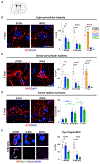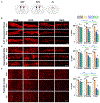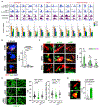An adult-stage transcriptional program for survival of serotonergic connectivity
- PMID: 35443166
- PMCID: PMC9109281
- DOI: 10.1016/j.celrep.2022.110711
An adult-stage transcriptional program for survival of serotonergic connectivity
Abstract
Neurons must function for decades of life, but how these non-dividing cells are preserved is poorly understood. Using mouse serotonin (5-HT) neurons as a model, we report an adult-stage transcriptional program specialized to ensure the preservation of neuronal connectivity. We uncover a switch in Lmx1b and Pet1 transcription factor function from controlling embryonic axonal growth to sustaining a transcriptomic signature of 5-HT connectivity comprising functionally diverse synaptic and axonal genes. Adult-stage deficiency of Lmx1b and Pet1 causes slowly progressing degeneration of 5-HT synapses and axons, increased susceptibility of 5-HT axons to neurotoxic injury, and abnormal stress responses. Axon degeneration occurs in a die back pattern and is accompanied by accumulation of α-synuclein and amyloid precursor protein in spheroids and mitochondrial fragmentation without cell body loss. Our findings suggest that neuronal connectivity is transcriptionally protected by maintenance of connectivity transcriptomes; progressive decay of such transcriptomes may contribute to age-related diseases of brain circuitry.
Keywords: CP: Neuroscience; Lmx1b; Pet1; amyloid precursor protein; axon degeneration; axonopathy; serotonergic connectivity; spheroids; synapse maintenance; transcription factor; α-synuclein.
Copyright © 2022 The Author(s). Published by Elsevier Inc. All rights reserved.
Conflict of interest statement
Declaration of interests The authors declare no competing interests.
Figures







Comment in
-
Transcriptional preservation of serotonergic connectivity may shed light on neurodegeneration.Trends Neurosci. 2022 Aug;45(8):563-565. doi: 10.1016/j.tins.2022.05.004. Epub 2022 May 24. Trends Neurosci. 2022. PMID: 35624030
Similar articles
-
LMX1B missense-perturbation of regulatory element footprints disrupts serotonergic forebrain axon arborization.Proc Natl Acad Sci U S A. 2025 Apr 8;122(14):e2411716122. doi: 10.1073/pnas.2411716122. Epub 2025 Apr 1. Proc Natl Acad Sci U S A. 2025. PMID: 40168115
-
Transcriptional preservation of serotonergic connectivity may shed light on neurodegeneration.Trends Neurosci. 2022 Aug;45(8):563-565. doi: 10.1016/j.tins.2022.05.004. Epub 2022 May 24. Trends Neurosci. 2022. PMID: 35624030
-
Lmx1b is required at multiple stages to build expansive serotonergic axon architectures.Elife. 2019 Jul 29;8:e48788. doi: 10.7554/eLife.48788. Elife. 2019. PMID: 31355748 Free PMC article.
-
Development of raphe serotonin neurons from specification to guidance.Eur J Neurosci. 2011 Nov;34(10):1553-62. doi: 10.1111/j.1460-9568.2011.07910.x. Eur J Neurosci. 2011. PMID: 22103413 Review.
-
Probing the diversity of serotonin neurons.Philos Trans R Soc Lond B Biol Sci. 2012 Sep 5;367(1601):2382-94. doi: 10.1098/rstb.2011.0378. Philos Trans R Soc Lond B Biol Sci. 2012. PMID: 22826339 Free PMC article. Review.
Cited by
-
Maintenance of neuronal identity in C. elegans and beyond: Lessons from transcription and chromatin factors.Semin Cell Dev Biol. 2024 Feb 15;154(Pt A):35-47. doi: 10.1016/j.semcdb.2023.07.001. Epub 2023 Jul 11. Semin Cell Dev Biol. 2024. PMID: 37438210 Free PMC article. Review.
-
Homeodomain proteins hierarchically specify neuronal diversity and synaptic connectivity.Elife. 2024 Jan 5;12:RP90133. doi: 10.7554/eLife.90133. Elife. 2024. PMID: 38180023 Free PMC article.
-
ATG8-dependent LMX1B-autophagy crosstalk shapes human midbrain dopaminergic neuronal resilience.J Cell Biol. 2023 May 1;222(5):e201910133. doi: 10.1083/jcb.201910133. Epub 2023 Apr 4. J Cell Biol. 2023. PMID: 37014324 Free PMC article.
-
Role of the circadian nuclear receptor REV-ERBα in dorsal raphe serotonin synthesis in mood regulation.Commun Biol. 2024 Aug 15;7(1):998. doi: 10.1038/s42003-024-06647-y. Commun Biol. 2024. PMID: 39147805 Free PMC article.
-
Embryonic motor neuron programming factors reactivate immature gene expression and suppress ALS pathologies in postnatal motor neurons.bioRxiv [Preprint]. 2024 Apr 5:2024.04.03.587963. doi: 10.1101/2024.04.03.587963. bioRxiv. 2024. Update in: Nat Neurosci. 2025 Aug 12. doi: 10.1038/s41593-025-02033-x. PMID: 38617322 Free PMC article. Updated. Preprint.
References
Publication types
MeSH terms
Substances
Grants and funding
LinkOut - more resources
Full Text Sources
Molecular Biology Databases
Miscellaneous

